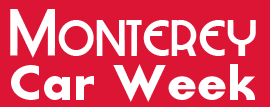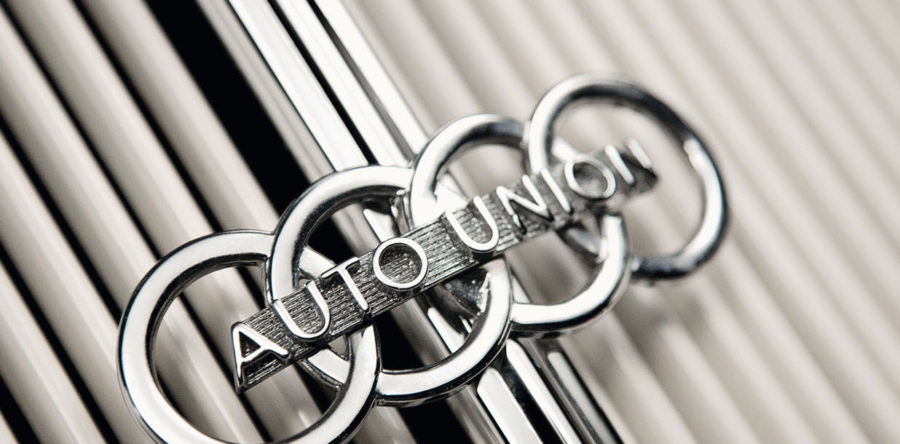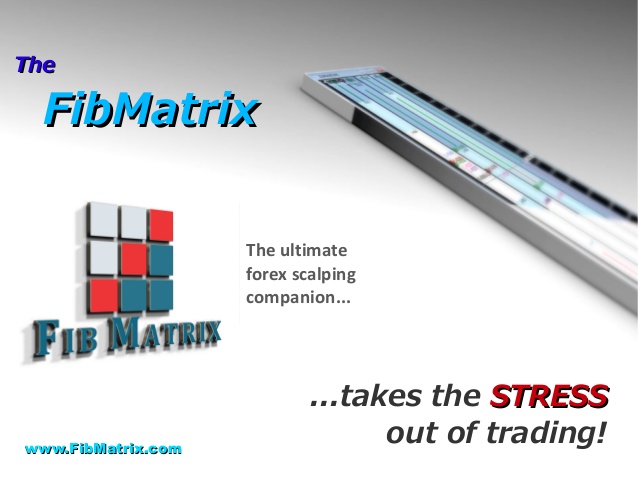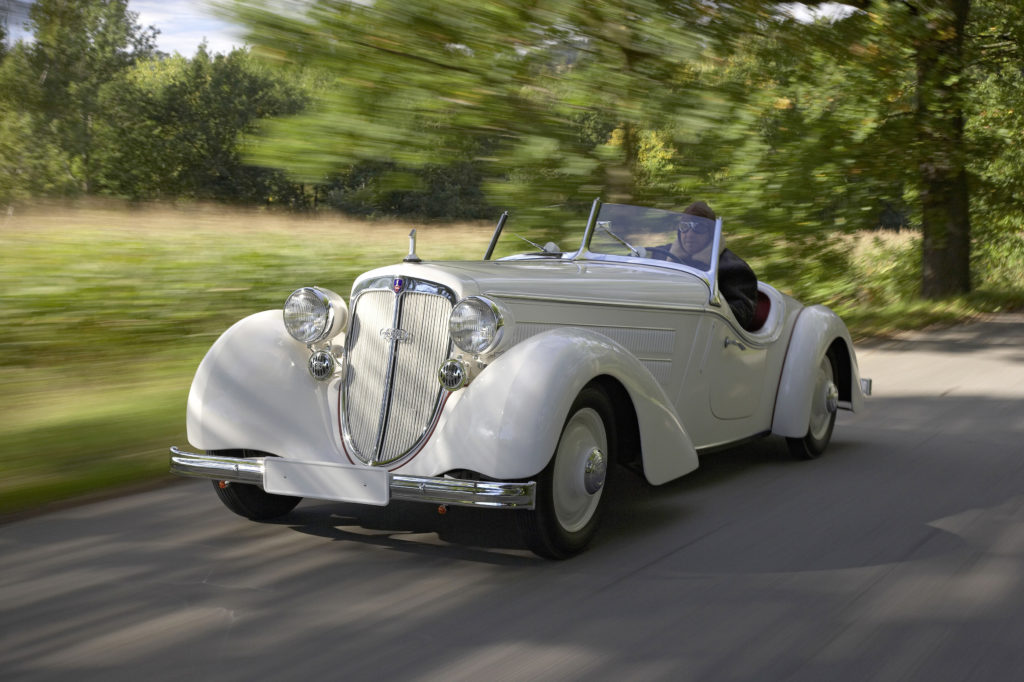
From the very start, the four interlinked rings were the brand emblem of Auto Union AG, which was the second-largest German motor-vehicle manufacturer when the company was formed in the town of Chemnitz in 1932. August Horch founded his first company back in 1899 and in 1873, Audi’s predecessor brand, NSU, came into existence. Today AUDI AG looks back on a 100-year history and thus on many anniversaries. Audi Tradition feels a connection with this history and celebrates these anniversaries with events, in publications or with special projects – including building a replica of the Audi Front 225 Roadster, which was presented as part of the “111 Years of Audi” anniversary in 2020.
AUDI AG can look back on a very eventful and varied history; its tradition of car and motorcycle manufacturing goes right back to the 19th century. The Audi and Horch brands in the town of Zwickau in Saxony, Wanderer in Chemnitz and DKW in Zschopau all enriched Germany’s automobile industry and contributed to the development of the motor vehicle. These four brands came together in 1932 to form Auto Union AG, the second largest motor-vehicle manufacturer in Germany in terms of total production volume. The new company chose as its emblem four interlinked rings, which even today remind us of the four founder companies. After the Second World War the Soviet occupying power requisitioned and dismantled Auto Union AG’s production facilities in Saxony.
Leading company executives made their way to Bavaria, and in 1949 established a new company, Auto Union GmbH, which continued the tradition associated with the four-ring emblem.
In 1969, Auto Union GmbH and NSU merged to form Audi NSU Auto Union AG, which since 1985 has been known as AUDI AG and has its head offices in Ingolstadt. The Four Rings remain the company's identifying symbol.
Horch
This company's activities are closely associated with its original founder August Horch, one of Germany's automobile manufacturing pioneers. After graduating from the Technical Academy in Mittweida, Saxony he worked on engine construction and later as head of the motor vehicle production department of the Carl Benz company in Mannheim. In 1899 he started his own business, Horch & Cie., in Cologne. In his automobile designs he was the first German engineer to use cast aluminium engine blocks and gearbox housings, to adopt shaft drive and to specify high-strength grades of steel for gearwheels. Horch moved his company to Saxony in 1902, initially to Reichenbach and two years later to Zwickau. In 1903 he began to build cars with a twin-cylinder engine. Later, in Zwickau, four-cylinder engines were built. These were very powerful units for their day, as proved by the success of a Horch car in the 1906 Herkomer Rally, the world’s most difficult long-distance event. Two years later the company for the first time sold more than a hundred cars within a year.
Following a dispute with the Executive and Supervisory Boards, August Horch resigned in 1909. He lost no time in establishing another automobile manufacturing company in Zwickau. Since he was unable to use his own name, which was registered by his former company, he adopted instead its Latin translation: “Horch” means “Listen!” and, in Latin, “Audi!”.
In the early 1920s, August Horch withdrew from active company management at Audiwerke AG and was appointed to the Supervisory Board. This was also the year in which he moved to Berlin and acted as an independent automobile expert and consultant. When Auto Union AG was formed in 1932, he was asked to join the Supervisory Board of the new company, and in this capacity continued to advise it on matters concerning technical development. In 1944 he moved from Berlin to the Saale river region, and spent his last years in Münchberg (Upper Franconia), where he died in 1951 at the age of 83.
August Horch was one of the pioneering automobile engineers, and a practical man through and through. With the remarkable technical innovations that he implemented so determinedly, he contributed significant stimuli to the development of motor transport from “horseless carriage” to automobile.
After August Horch left the company that bore his name, the model programme based on his ideas and development work continued in production. After the First World War the Argus aircraft engine company acquired a majority shareholding in Horch. This led to two of the most famous engine designers, Arnold Zoller and later Paul Daimler, Gottlieb Daimler’s son, occupying the post of Chief Designer at the Horch automobile factory in Zwickau.
In the autumn of 1926 the Horch company introduced a new model with a straight-eight engine designed by Paul Daimler. This engine was notable for its reliability and refinement, and became the yardstick that all Horch’s competitors were obliged to match. The Horch 8 became a synonym for elegance, luxury and demanding standards in automobile construction.
In the autumn of 1931 the Horch company in Zwickau unveiled its new top product at the Salon de l’Automobile in Paris: a sports convertible with a twelve-cylinder engine; the exhibit was painted in brilliant yellow and had a brown hood and green leather upholstery. However, only 80 of this magnificent Horch model found buyers between 1932 and 1934. As a result of the world economic crisis, the market for luxury cars of this type had collapsed. Horch was market leader in the whole large-car category, and booked a third more sales than its competitors In 1932, for instance, it delivered 773 cars to customers in Germany and exported about 300, but this level of business was still not sufficient in times of economic crisis to guarantee the company’s continued existence.
Audi
After parting company from Horch Motorwagenwerke AG, August Horch established a new company in 1909, again with the declared aim of building automobiles. Since Horch was unable to make further use of his own name as an automobile brand, he resorted to the device of translating his own name into Latin: “Horch“ (“Listen!“) became “Audi”. This was the starting point for the Audi factory in Zwickau. August Horch delivered the first car to bear the new Audi brand name in May 1910. The new model gained immediate respect by scoring an unrivalled series of successes in the International Austrian Alpine Rally, at that time the toughest long-distance competition of its kind. Audi won this event in three successive years: 1912, 1913 and 1914. After the First World War the Zwickau-based company attracted attention in 1921 by being the first German car manufacturer to adopt left-hand drive and opt for a central, floor-mounted gear lever. This gave the driver better control over the car in traffic, so that all other German automobile manufacturers followed suit in subsequent years.
The first Audi with a six-cylinder engine was introduced in 1923. It was equipped with an oil filter and air cleaner, not a widespread device at that time. An air cleaner did not become a standard feature until some years later. The Audi six-cylinder model was also among the first cars in Germany to have hydraulic brakes at all four wheels; the design was developed in-house at the Audi development department in Zwickau. In 1927, Chief Designer Heinrich Schuh introduced Audi’s first eight-cylinder car, the “Imperator”: an imposing vehicle, but one that reached the market too late, since sales of large luxury cars were falling. The company found itself in financial difficulties and was purchased in 1928 by Jörgen Skafte Rasmussen, the owner of the DKW business enterprise.
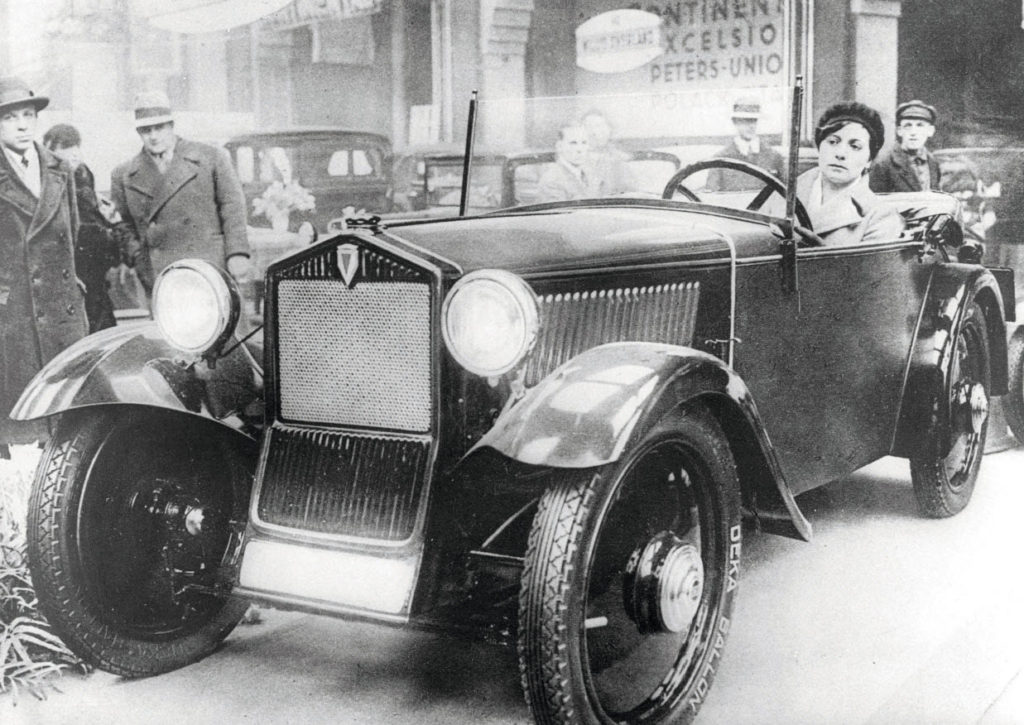
DKW
Jörgen Skafte Rasmussen was Danish by birth, but gained a foothold in the business world in Germany’s Free State of Saxony after having studied engineering in Mittweida. At the end of 1902 he established a company manufacturing pipe fittings in Chemnitz; five years later he moved to Zschopau, in the Erzgebirge mountains, and in 1916 began to experiment with a steam-driven car. Although his efforts were not crowned with success, the name of the project, or rather its German initials, were adopted from then on by Rasmussen as a brand name. In the autumn of 1918 Rasmussen acquired plans for a two-stroke engine developed by the engineer Hugo Ruppe; this small-scale toy engine was promptly scaled up and launched in August 1919 as an auxiliary engine for bicycles. The first DKW motorcycle was the “Reichsfahrt” model in 1922, named for a national rally event. During the 1920s, under Rasmussen’s supervision and with the aid of his sales director Carl Hahn and chief designer Hermann Weber, DKW became the world’s leading supplier of motorcycles, and was also a market leader for stationary engines.
In 1927 Rasmussen purchased the designs and production lines for the six- and eight-cylinder engines manufactured by the bankrupt Detroit carmaker Rickenbacker. Two new Audi models with these engines were subsequently introduced. Despite this, Rasmussen could see the writing on the wall and concentrated his efforts on small cars. The first cars produced by DKW had rear-wheel drive and were built in Berlin-Spandau, but at the end of 1930 Rasmussen instructed the Audi factory in Zwickau to develop a car with the following specifications: 500-cc or 600-cc twin-cylinder two-stroke engine as already used for a motorcycle, load-bearing wooden body with imitation leather surface material, swing axles at front and rear and front-wheel drive. This was to be the first “DKW Front”, and was the work of Audi designers Walter Haustein and Oskar Arlt. The new model was exhibited at the 1931 Berlin Motor Show, and attracted considerable attention. It was assembled at the Audi factory in Zwickau and within a short time became one of the most popular, best-selling small German cars of that period.
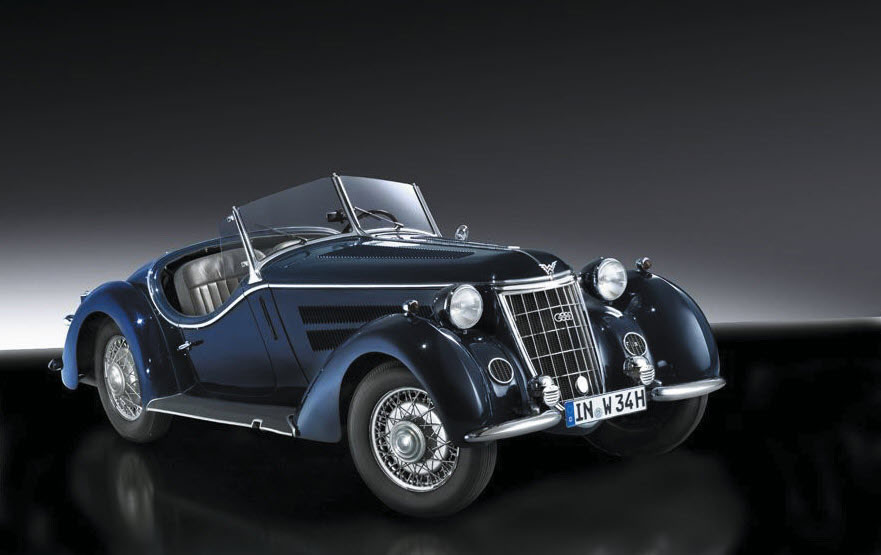
Wanderer
As a brand name, Wanderer goes back to 1886, when it was registered for the bicycles built by the Winklhofer & Jaenicke company, itself founded in Chemnitz a year earlier. In 1896 this was converted into a joint-stock company named Wanderer-Fahrradwerke AG, after which the product programme was steadily enlarged. Starting in 1899 milling machines were sold, of a type the company had previously built for its own use. The first Wanderer motorcycles left the factory in Chemnitz-Schönau in 1902; two years later typewriters bearing the Continental brand name were manufactured, and in 1906 the prototype of the first “Wanderermobil” was seen. The first small car to reach production, however, was the “Puppchen” (“Baby Doll”) in 1913, which became extremely popular. After the First World War Wanderer concentrated on manufacturing small cars until the autumn of 1926, when it changed its policy and ventured into the medium-size category with the Wanderer W 10. This model had a 1.5-litre, four-cylinder engine with an output of 30 hp, and featured all the contemporary automobile engineering innovations then reaching the German market, such as left-hand drive, a central floor-mounted gear lever, a multi-plate dry clutch, the gearbox in unit with the engine block and four-wheel brakes.
Sales were so good that Wanderer built a new factory in the Siegmar suburb of Chemnitz, and moved production of machine tools there as well. Two-wheeled vehicles and office machinery remained at the old factory in Schönau. In the autumn of 1928 the W 11, the first Wanderer to have a six-cylinder engine, was introduced – evidence that Wanderer intended to position its cars farther up-market.
Wanderer had acquired a brand image of exceptional production quality and reliability. Customers were prepared to pay slightly higher prices for these attributes. In the crisis years at the end of the 1920s, an effort was made to maintain sales by means of bodies of modern design and more powerful engines. The will to innovate was undoubtedly present, but demand was so poor that production figures declined rapidly. Wanderer’s automobile division was “in the red”. Motorcycle production had already been sold off to NSU and the Czech businessman F. Janeček. The Dresdner Bank, Wanderer’s largest shareholder, now began to examine the idea of disposing of the automobile side of the business as well, and concentrating instead on machine tool and office machinery production, areas that were still profitable.
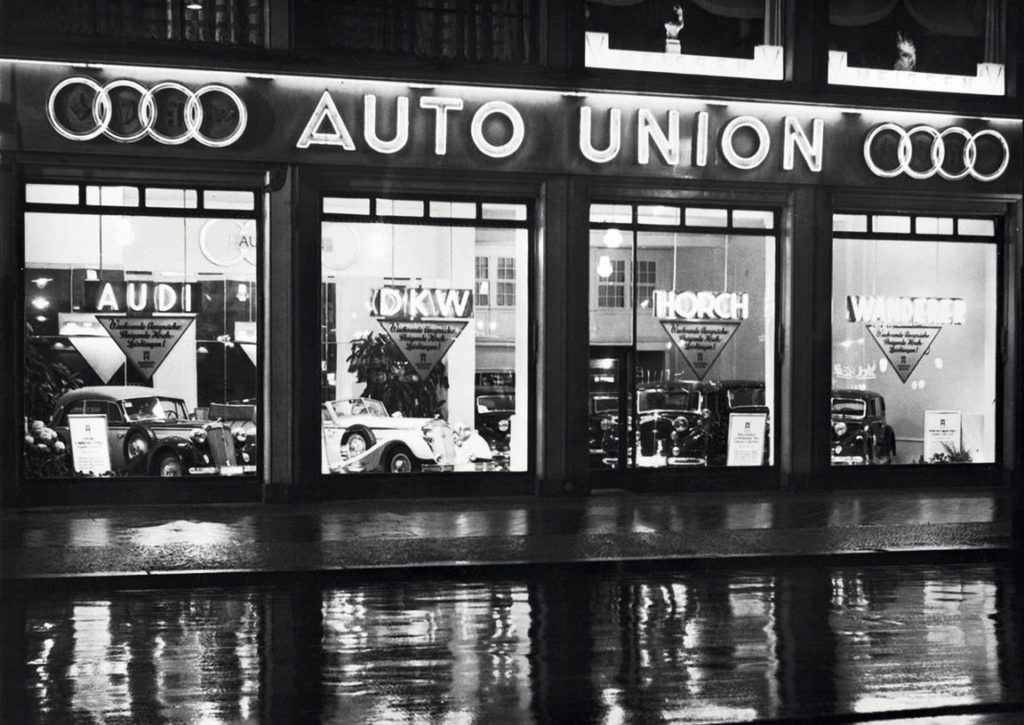
Four rings, four brands: Auto Union AG
Like the entire automobile industry, Audi, Horch, DKW and Wanderer had taken the opportunity in the 1920s to streamline their production. Conveyor-belt assembly lines and modern machine tools increased potential output considerably. Mass production was possible, subject only to demand limits. Large sums of money had to be invested in an attempt to boost sales. Foreign manufacturers penetrated the German market, which led to cut-throat competition. In many cases the German automobile industry was unable to raise the necessary funds from its own profits, and had to turn to outside investors.
For the Horch company in Saxony, the primary source of funds had been the State Bank of Saxony, which also financed the expansion of the Rasmussen Group. Following a “united we stand” policy, the bank resolved to group its automobile industry interests together. This was the origin of what was to become the “Auto Union”. The leading role was allocated to Zschopauer Motorenwerke J. S. Rasmussen AG, which on 29 June 1932 took over Audiwerke AG (though in fact its equity was already in the hands of J. S. Rasmussen) and Horchwerke AG. In addition, a purchase and rental agreement was signed with the automobile division of Wanderer. The participating companies had already decided that the new name should be “Auto Union AG”. 80 percent of its equity of 14,500,000 Reichsmarks was held by the State Bank of Saxony.
Creating a competitive structure
Formation of Auto Union AG created the second-largest automobile manufacturing group in Germany. The emblem it adopted consisted of four interlinked rings, symbolising the four companies in the Saxony region of Germany that had now amalgamated: Audi, DKW, Horch and Wanderer, together with their product portfolios, determined the image possessed by Auto Union AG on the motor-vehicle market. In order to offer customers a full range of models and avoid internal competition as far as possible, each brand was allocated a specific market segment. Motorcycles and small cars for DKW, midsize cars for Wanderer, premium upper midsize models for Audi and large luxury cars for Horch. This model programme may have seemed rather arbitrary at first in view of the individual traditions of the four founder-companies, but only a few years were needed to develop and implement a unified concept to which each company made its contribution.
Model policy and model development under the sign of the Four Rings
In February 1933, the Auto Union exhibited at the Berlin Motor Show for the first time as a new, joint company. The Audi brand aroused great interest by adopting front-wheel drive in the midsize car segment. The new model’s share of registrations, however, subsequently remained modest: customers were not prepared to risk their money on such a technical novelty. The company altered its policy and, in 1938, introduced the Audi 920, a powerful car of extremely modern appearance. Its overhead camshaft (OHC) engine was a new design, developing 75 horsepower and capable of propelling the car as fast as 140 km/h – an Audi for customers who wanted a powerful car rather than a large one, an Audi for dynamic, enthusiastic drivers. Front-wheel drive was discarded in favour of rear-wheel drive, and the central box-section chassis frame was more conventional, with box-section side members. Either a six-window saloon body or a two-door convertible with four windows was available. Such was public demand for the Audi 920 that it was sold out for more than a year only shortly after its introduction.
With its motorcycles and small cars, DKW catered for the market segment up to a price of 3,400 Reichsmarks. In 1933 the motorcycle programme consisted of eight models, with engine sizes between 175 and 600 cc. In the following year the RT 100 was introduced. Its simple design clarity and performance set standards that persisted unchanged for several decades. The RT sold at an unrivalled 345 Reichsmarks and was among the motorcycles produced in the largest numbers at that time.
The Zschopau-based motorcycle manufacturer relied at this time mainly on the 200-cc class for its sales volume. DKW was the market leader, a situation that did not change in 1938 when, in parallel with the successful RT 100 and KS 200 models, DKW launched its NZ model line. These attractive motorcycles with four-speed gearbox, foot-operated gear change and (on the NZ 500) rear suspension were available with a 250, 350 or 500-cc engine and clearly demonstrated the high level of development reached by DKW’s two-stroke models. The DKW RT 125 reached the market shortly before the outbreak of the Second World War. With its low weight and excellent practical features, it combined all the know-how that DKW’s Zschopau factory had acquired in the production of lightweight motorcycles.
DKW built its cars in Berlin-Spandau (rear-wheel drive, V4 two-stroke engine using the split-single principle) and in Zwickau (front-wheel drive, twin-cylinder inline two-stroke engine). All the engines cane from Zschopau; the wooden bodies for the front-wheel-drive DKWs assembled in Zwickau were delivered from the Spandau factory. The German Reichsbahn carried them by rail to Zwickau for eight Reichsmarks per body.
DKW’s front-wheel-drive cars (designated F 2 to F 8) were sold as two model lines, the ‘Reichsklasse’ (600-cc engine, 18 horsepower) and the ‘Meisterklasse’ (700-cc engine, 20 horsepower). There were luxury front-wheel-drive models too: highly attractive convertibles with a pressed-steel body. Front-wheel-drive cars from DKW were among the most popular, best-selling small cars in Germany. In the 1930s, the manufacturer’s output of these cars reached a quarter of a million. Their front-wheel drive was a pioneering innovation. It was planned to replace the cars built in Spandau and those from Zwickau with the F 9, which was to have a pressed-steel body and a new 28-hp three-cylinder engine, but the launch scheduled for 1940 never came to pass because of the Second World War.
For more than twenty years, Horch cars from Zwickau had built up a high reputation for quality and luxury. The engines in particular set new standards of power flow and refinement. Fuel economy was regarded as being of only minor importance in the large luxury car class. The “Horch 8” was the epitome of high quality. It reached the market in 1933, with a V8 engine designed by Fritz Fiedler, initially of 3.0 litres’ capacity but later enlarged to 3.5 and then 3.8 litres. During this period its power output increased from 70 to 92 hp, though compared with the models with a 120-hp straight-eight engine, it remained the “small Horch”. Both these model lines retained rigid axles, which made them very difficult to handle at high speeds.
In 1935 Horch cars were converted to independent front suspension, with a
De Dion axle at the rear (a layout with double universal-joint half-shafts, a beam axle and the differential mounted on the main chassis frame). In the same year the Type 853 straight-eight sports convertible was introduced. Experts and the public alike declared it to be the most attractive Horch ever built. The Horch easily maintained its market lead in the luxury segment for cars with engines of more than 4 litres’ capacity: in 1937 for instance, its market share rose to more than 50 percent.
When the Auto Union was formed, Wanderer introduced a model with a six-cylinder overhead valve (OHV) engine designed by Professor Porsche. It had a light alloy cylinder block. Wanderer had already enlisted Ferdinand Porsche’s services in 1931. Using the new engine, the company began to develop cars with modern chassis and bodywork. In 1933 these models had a rigid front axle and swing-axle rear suspension (Types W 21/W 22), but in 1936 independent front suspension was adopted (W 40, 45, 50). The models sold in the transitional period of 1935 had three-digit type numbers (W 240, 250 etc.).
The OHV engine, which was reliable but very expensive to build, was replaced in 1937 by a new generation of side-valve engines: a four-cylinder, 42-hp unit in the W 24 model and a six-cylinder with an output of 62 hp in the W 23, W 26 and W 52. These engines, and also the chassis, were already largely standardised. The Wanderer W 51 model line and the W 25 K sports car with supercharged six-cylinder engine acquired a new Auto Union-styled body in 1936. Influenced by contemporary American cars, this styling would be found from that time on – modified to a greater or lesser extent – on all the Group’s new models.
Motor sport
To achieve widespread public awareness of the Auto Union name, the Chemnitz-based company was actively engaged in motor sport from the outset. As early as 1933 it concluded an agreement with Ferdinand Porsche for the development of a Grand Prix racing car, which then debuted in May 1934 on the Avus circuit in Berlin. The car’s design was unusual in many respects: V 16 engine with Roots supercharger, engine located behind the driver (we would speak today of a “mid-engine” car) and torsion-bar front suspension with trailing arms.
Between 1934 and 1938 the 16-cylinder racing car was continually improved and its power output raised from the initial 295 hp (Type A) to 520 hp (Type C). Outstanding victories on international racetracks – with stars such as Hans Stuck, Achille Varzi and, above all, Bernd Rosemeyer at the wheel – soon made the Auto Union, although founded only a short time before, known to the public worldwide. The world speed record run on the Frankfurt-Darmstadt ‘autobahn’ in October 1937, with Rosemeyer driving a streamlined version of the car, aroused enormous interest: he was the first person to drive a car on a public highway at more than 400 kilometres an hour.
The races for which these ‘Silver Arrows’ were entered in the 1930s soon created a legend. Mercedes-Benz and Auto Union were almost unbeatable on the world’s racing circuits. In 1938 a three-litre formula was adopted, and the Auto Union sent its Type D, with 485-hp V 12 engine, to the starting line. After the death of Bernd Rosemeyer in the course of a further world speed record attempt in January 1938, the Italian driver Tazio Nuvolari took his place as the leading Auto Union driver.
In addition to the powerful publicity effect obtained from its Grand Prix racing activities, the Auto Union also entered DKW motorcycles for races and cross-country events; specially prepared DKW and Wanderer sports cars took part in long-distance races such as Liège-Rome-Liège and in off-road reliability trials.
Centralisation
Just as the Auto Union initially retained the well-established product programmes of its individual brands, so the new group at first allowed prevailing business structures to continue. In its first years the group was run from Zschopau (DKW). In 1936 a new administrative building was completed in Chemnitz.
From 1935 on, in parallel with the individual factories’ development departments, a central design office (ZKB) and a central experimental establishment (ZVA) were set up there. They developed and tested the group’s new models and their components from that time on, applying proven scientific methods more frequently than had been done previously. A technological department investigated all matters relating to materials, developed new alloys and specific manufacturing processes and subjected all new designs to technological suitability tests. Another department staffed by scientists developed modern engines and transmissions. Last but not least, a technical testing department was responsible for a programme of practical experimental work, for trials of production vehicles, subsequent quality assurance and comparisons with competitors’ products.
In the engine construction area, special attention was devoted to the two-stroke engines. Auto Union had acquired an exclusive licence to use the Schnürle patents (a reverse scavenging principle for two-stroke engines) on its small engines from Klöckner-Humboldt-Deutz. This principle not only achieved a distinct reduction in fuel consumption but also boosted power output by an equivalent amount.
One of the very first work areas taken up by the central body development and design office (ZKEKB) was further development of “streamlined” car bodies, using patents held by the Swiss areodynamicist Paul Jaray. Optimum airflows were first calculated theoretically, then tested in the wind tunnel. Compared with the figure of 0.58 for the previous F 8 model, series-production bodies for the DKW F 9 recorded the remarkably low drag coefficient of cd = 0.42 – a figure that would not be surpassed by a German production car for decades to come.
Auto Union began cooperation in the mid-1930s with Dynamit AG in Troisdorf, the aim being to develop a plastic body for DKW. One reason for this was that increasing demands by the military authorities were causing shortages of steel and rubber; another was that DKWs were still using wooden bodies built by hand and covered with imitation leather, a costly and time-consuming procedure. An empirical crash-test programme was drawn up in order to establish the relative strengths of wood, sheet metal and plastic. These were the first-ever crash tests in the history of the Germany automobile industry; special fixtures were designed, for instance a catapult for impact testing and a track with a downhill gradient for roll-over tests.
In the late 1930s, the company planned to erect a factory in Chemnitz to utilise the very latest continuous assembly-line production methods. It was intended to build DKW and Wanderer cars there in high volume, but the outbreak of war put paid to these plans and the factory was never built.
Commercial development
Between 1933 and 1939 the Auto Union expanded to an enormous extent. The Group's consolidated sales rose from 65 to 276 million Reichsmarks (RM) and the workforce increased from 8,000 to more than 23,000. Annual output of motorcycles rose from just under 12,000 to 59,000, and of cars from rather more than 17,000 to over 67,000. Compared with the figures for the year in which the Auto Union had been formed, output of Horch cars had doubled by 1938. In the same period production of Wanderer cars increased fivefold and of DKW cars more than tenfold. One in four passenger cars registered for the first time in Germany in 1938 came from the Auto Union, and more than one motorcycle in three was a DKW.
War and liquidation
When the Second World War broke out, this expansion came to an abrupt end. Auto Union AG built its last vehicles for civilian use in 1940/41, and was then obliged to manufacture products for the war effort. Due to mass conscription to the army the shortage of workers intensified. In order to satisfy the increased demand for German war machinery the Nazi regime started to use foreign workers in 1941/42. Today it is estimated that between 11 and 12 million men and women were part of the foreign workforce in the German Reich during the Second World War. The use of labour in Germany increasingly developed into forced labour.
As the German war industry reached the limits of its working resources in 1943/44, the Nazi regime allowed access to hundreds of thousands of SS concentration camp prisoners. For them, employment in the war industry under unspeakable working and living conditions usually meant “death through work”. In spring 1945 there were around 17,300 forced labourers and prisoners of war working in the Auto Union group as well as 3,700 concentration camp prisoners.
At the end of the war the Soviet Army of Occupation expropriated Auto Union AG and dismantled its production facilities. In 1948 the company was struck out of the trade register of the town of Chemnitz.
Starting afresh in Ingolstadt
On 3 September 1949 a company was formed in the southern German town of Ingolstadt: Auto Union GmbH. Its purpose was to continue the tradition embodied in the four-ring emblem. This new company can be regarded as the predecessor of today’s AUDI AG.
It was a humble beginning: small, economical vehicles were urgently needed. This explains why the new company initially built only the DKW brand’s motorcycles and cars with their typical two-stroke engines. Establishing Auto Union GmbH in 1949 was in fact the second step: only shortly after the war ended, on 19 December 1945, a central depot for Auto Union spare parts had been registered as a limited partnership in Ingolstadt. Its task was to supply parts needed for pre-war Auto Union vehicles still operating in the western occupied zones – no fewer than 60,000 DKW cars and a large number of Wanderer, Horch and Audi cars.
Why was Ingolstadt chosen?
Several factors led to Ingolstadt being chosen as the location for the central spare parts depot. It was in the heart of the Bavarian region, with good infrastructure connections, and the town council in Ingolstadt recognised its importance for the regional employment market. Possibly the decisive factor in its favour, however, was the fact that Ingolstadt had been a military garrison for several centuries, and the extensive parade grounds, large storehouses and barracks were invaluable at a time when funds for new buildings were scarce. The central depot for Auto Union spare parts therefore found suitable premises in the former Army Provisions Offices, and used a former military bakery as its warehouse.
A new Auto Union
From the outset, those involved in establishing the central spare parts depot were aware that this was only an intermediate step. In parallel with this, the former Auto Union directors and top managers were determined to create suitable conditions for restarting vehicle production. It was obvious to them that to achieve this effectively from nothing would only be possible with the proven DKW motorcycle and car designs, with their simple but sturdy design and two-stroke engines.
From its base in the former Military Provisions offices on Schrannenstrasse, Auto Union was able to expand into other former military buildings in the centre of town. They included the former arsenal, in which the first vehicle designed in Ingolstadt took shape during 1948. This was a DKW delivery van with front-wheel drive and the trusty twin-cylinder two-stroke engine as used before the war. This small van with its modern forward-control body was shown to the public for the first time at the Hanover Export Trade Fair in May 1949. With a degree of pride, the Auto Union declared: “DKW is back!”
Auto Union GmbH was officially established on 3 September 1949 as the new production company. More and more former employees from Saxony found their way to Ingolstadt with the aim of participating in the brand’s revival. Since the production shops were scattered throughout the town centre, rational flows of materials or components were hardly ever possible. The workforce joked that it worked for the “consolidated shed company”. The first Auto Union products at this time were thus the DKW F 89 L express delivery van and the RT 125 W motorcycle, the “W” (for “West”) in the latter’s name being an attempt to make clear that this was not the same product as had originally been developed in Zschopau, in other words in East Germany.
A car was still lacking, however, and it was planned to use the DKW F 9 as a basis. This model had reached the prototype stage by 1940 in Chemnitz. After the war, the technical facilities for building the proposed three-cylinder, two-stroke engine were no longer available, and the Ingolstadt engineers therefore resorted to the 700-cc twin-cylinder engine from the pre-war DKW F 8. This combination of F 8 and F 9 technical features explained the model designation given to the new model: F 89.
There was no production capacity to build the F 89 passenger car in Ingolstadt. The Auto Union therefore took over a largely destroyed Rheinmetall-Borsig factory in Düsseldorf, and converted it for passenger-car production. The first of the new DKW “Meisterklasse” cars left the assembly line there in August 1950.
A new model was introduced in 1953, the DKW 3=6 Type F 91 or “Sonderklasse”. It had a three-cylinder engine and formed the backbone of the Auto Union’s passenger-car programme for a number of years. Sold in several versions – saloon, coupé, convertible and estate car – the 3=6 became a symbol of West Germany’s economic miracle.
Under the Daimler-Benz roof
In 1954 the industrialist Friedrich Flick became a partner in Auto Union GmbH. He soon realised that the Ingolstadt automobile manufacturer needed a partner capable of providing a major injection of capital if it were to continue to play a leading part on the German automobile manufacturing scene. In 1957 Flick therefore proposed that the Auto Union should be taken over by Daimler-Benz. He already held 41 per cent of the Auto Union company’s equity as well as more than 25 percent of Daimler-Benz’s shares. After some hesitation, the decision-taking executives at Daimler-Benz in Stuttgart agreed to this transaction. In view of growing competition from abroad, Daimler-Benz AG was planning to enlarge its production programme and enter the smaller-car market segment.
On 24 April 1958 Daimler-Benz AG acquired an approximately 88-per-cent share in the Auto Union, paying rather more than 41 million Deutschmarks (DM) for it. A year later, in 1959, it also acquired the remaining shares. The number five in the German automobile industry had been absorbed by the number two company or, as Daimler’s Executive Board spokesman Fritz Könecke commented: “We have married a nice girl from a good, old-established family!” On 9 April 1958 the business newspaper ‘Handelsblatt’ wrote: “By absorbing Auto Union GmbH with its annual turnover of about 400 million DM and a workforce of 10,000, the Daimler-Benz group has now regained pole position in terms of turnover in the West German automobile industry.”
A new factory in Ingolstadt
Due to lack of capital at this time, Auto Union had postponed production of a modern, reasonably priced small car that had been under development since the mid-1950s and was later to be known as the “DKW Junior”. Although finance for this overdue project was forthcoming following the take-over by Daimler-Benz, the necessary production capacity was still not available.
A new factory would have to be built as quickly as possible, either in Ingolstadt or in Zons, near Düsseldorf, where large plots of land had already been purchased. Fritz Böhm, at that time Chairman of the Ingolstadt Works Council and also a member of the Bavarian State Parliament, fought hard in favour of the Ingolstadt location. He was well aware that if the choice fell on Zons, this would sooner or later mean the end of motor-vehicle production in Ingolstadt. Another circumstance that spoke for the Bavarian town was the plan to cease motorcycle production there in the autumn of 1958. This would release a considerable number of well-qualified employees for the new car production facility – an advantage not available in Zons but at that time, the end of the 1950s, a very significant argument.
The decision went in favour of Ingolstadt, not least because of a 25 million Deutschmark loan from the State Bank of Bavaria. Construction work began in July 1958 on the northern periphery of the town. The Donau Kurier newspaper waxed euphoric: “Near Ingolstadt one of the largest, most modern car factories in Europe is taking shape.” A year later, in July 1959, the first DKW Junior left the assembly line in the new Ingolstadt factory.
Volkswagen takes over the helm
At the end of 1958 Auto Union employed 3,700 people in Ingolstadt; twelve months later the total had grown to 5,700. But construction of the new factory not only resulted in more employees being recruited: it also led to the company’s head offices being moved from Düsseldorf to Ingolstadt in the autumn of 1961, and, by the middle of 1962, to the concentration of all production activities in the town on the River Danube. In April 1962 the company sold the Düsseldorf factory to Daimler-Benz, which used it to build Mercedes delivery vans. The workforce at Auto Union’s Ingolstadt location, however, rose beyond the ten thousand mark for the first time, a situation that led to changes in the town’s urban character: new housing estates were built and many suppliers moved their business premises to be close to their principal customer.
Although concentration of the company’s activities at a single point achieved the desired rationalisation and cost-reduction effects, the two-stroke DKW models that Auto Union was still building were becoming increasingly obsolescent. The two-stroke engine that was a typical DKW feature lost ground not only with experts in the trade but also with the public. None the less, the two-stroke model range was modernised once again with technical assistance from Daimler-Benz. The DKW Junior was followed by the F 12, and in the autumn of 1963 the DKW F 102 superseded the Auto Union 1000 model. Plans were drawn up at the same time for an Auto Union four-stroke engine. For this project, Daimler-Benz despatched a team of technical experts to Ingolstadt, including Ludwig Kraus, who was later appointed Head of Development.
Despite these measures, the Auto Union’s turnover fell uninterruptedly from 1962 onwards. It was time for major Daimler shareholder Friedrich Flick to pull another rabbit out of the hat: at the end of 1964 ownership of Auto Union GmbH passed in successive stages to Volkswagenwerk AG.
The VW takeover finally meant the demise of the once so popular two-stroke engine. Almost 30,000 DKW cars were unsold and had to be stockpiled. Salvation came in the form of the VW Beetle: between May 1965 and July 1969 the Ingolstadt workforce built almost 348,000 of VW’s 1200 and 1300 models. Economic pressure showed signs of relaxing when, in August 1965, the new “Audi” was introduced, with Ingolstadt’s first four-stroke engine installed in the F 102 body. The new car aroused keen customer interest and proved to be a sound basis for a complete range of models to be built up.
In November 1968 Auto Union announced its Audi 100. With a modern body built using systematic weight-saving methods, and a well-planned front-wheel drive layout, the latest product to emerge from Ingolstadt was highly convincing. The German car magazine ‘auto motor und sport’ wrote: “In the sum total of its qualities it clearly occupies a leading position on the current market for midsize cars.” More than that: it secured the Ingolstadt car manufacturer the autonomy it needed for the future.
On March 10, 1969 Auto Union GmbH signed a merger agreement with NSU Motorenwerke AG, backdated to take effect from 1 January 1969. This agreement established Audi NSU Auto Union AG, with registered offices in Neckarsulm.
A retrospect of NSU
Established in 1873 by Christian Schmidt and Heinrich Stoll as a knitting machine workshop in the town of Riedlingen an der Donau, the company moved to Neckarsulm in 1880, and was converted into a share-issuing company in 1884. In 1886 the proprietors took the right decision at the right time: the bicycle began its triumphal success story worldwide, and from that time on – for the next 77 years in fact – bicycles from Neckarsulm were noted for their proverbial quality.
Motorcycles joined the production programme from 1900 on, and the new brand name “N.S.U.” (for NeckarSUlm) was introduced to world markets, where it remained in uninterrupted use until 1967. Another development was shown to the public in 1906 too, the first “Original Neckarsulmer Motorwagen” — a compact midsize automobile with a water-cooled four-cylinder engine. In 1909 the workforce of 1,000 built 450 automobiles, and in 1914 the Neckarsulm technical experts explored the use of weight-saving aluminium for the first time: their Type 8/24 PS midsize model had an aluminium body.
When the First World War broke out in 1914, the military authorities exhibited great interest in motorcycles and cars manufactured in Neckarsulm, and before long were absorbing almost the entire production. This enabled the company to expand even in times of war. Nor did the period of hyperinflation that followed have any severely adverse effects. By 1923, the workforce had grown to 4,070, and could proudly claim to be building a car every two hours, a motorcycle every 20 minutes and a bicycle every five minutes. In 1924, when the need for more space became acute, a new automobile production plant was built in Heilbronn, but two years later turnover dropped for the first time, and financial problems arose. In 1929, the company had no choice but to halt automobile production and sell the Heilbronn plant constructed only four years previously to Fiat. The new owners continued to manufacture cars there, badged as NSU-Fiat, until 1966.
After this, NSU concentrated on the production of two-wheeled vehicles. In 1929, it took over most of the Wanderer company’s motorcycle division, and in 1932 established a joint sales operation with the D-Rad brand built by Deutsche Werke in Berlin. In 1933/34, NSU assembled three prototypes of a car designed by Professor Porsche, powered by an air-cooled, 1.5-litre horizontally opposed engine installed at the rear, and in their general concept very similar to the Volkswagen “Beetle” which appeared later. Series production of the Porsche design, however, was out of the question because of a lack of funds. In the 1930s, NSU was alongside BMW and DKW one of the leading German motorcycle brands. At the end of 1936, when it took over Opel’s bicycle manufacturing operation, NSU also became one of Germany’s largest bicycle manufacturers. By the end of the war in May 1945, large parts of the plant in Neckarsulm were in ruins.
Rebuilding after the war concentrated on NSU bicycles, which were in strong demand, and on the 98-cc NSU Quick motorcycle. This was soon followed by 125- and 250-cc models. Later the programme included such highly regarded motorcycles as the NSU Fox, NSU Lux, NSU Max and the 500-cc NSU Konsul. By winning five world motorcycle racing championships between 1953 and 1955, and by setting a complete series of new world motorcycle speed records in 1956, the company acquired a high international reputation. Despite these successes, however, the management in Neckarsulm was only too well aware that from the mid-1950s on West Germany’s motorcycle industry was in the throes of a severe downturn. For NSU, although still the world’s largest manufacturer of two-wheeled vehicles in 1955, it was clearly time to initiate a revival of automobile production. The result was the “Prinz”, a new style of small car, with which NSU returned successfully to the automobile scene in 1958. A year before this, the first Wankel rotary piston engine had sprung to life on an NSU test rig. By 1963, the company was ready to write a new chapter in automotive history with the NSU/Wankel Spider, the world’s first series-production car with a Wankel engine. Between 1965 and 1968, it won three German race championships. Next to appear was the NSU Ro 80, a revolutionary design in every way and the first German model to be voted “Car of the Year”. But then came 21 August 1969, when Audi and NSU agreed to join forces and NSU ceased to be independent after almost a hundred years.
Vorsprung durch Technik
In August 1969, a merger took place between Auto Union GmbH, Ingolstadt, and NSU Motorenwerke, Neckarsulm. The two subsidiaries of Volkswagenwerk AG merged to form Audi NSU Auto Union AG, with registered offices in Neckarsulm. The new company’s model range was characterised by its wide diversity: from the air-cooled engines of the NSU Prinz model line and the water-cooled four-cylinder engines in the Audi 60 and Audi 100, to the fascinating Wankel engine in the Ro 80; from the front-wheel drive in the Audi models and Ro 80 to the rear-wheel drive of the NSU Prinz and TT; from the lightweight construction of the Audi 100 to the Italian styling of the Audi 100 Coupé S and the futuristic body design of the NSU Ro 80. The variety of technical concepts in the Audi NSU model range led to a new advertising slogan being adopted in January 1971: Vorsprung durch Technik!
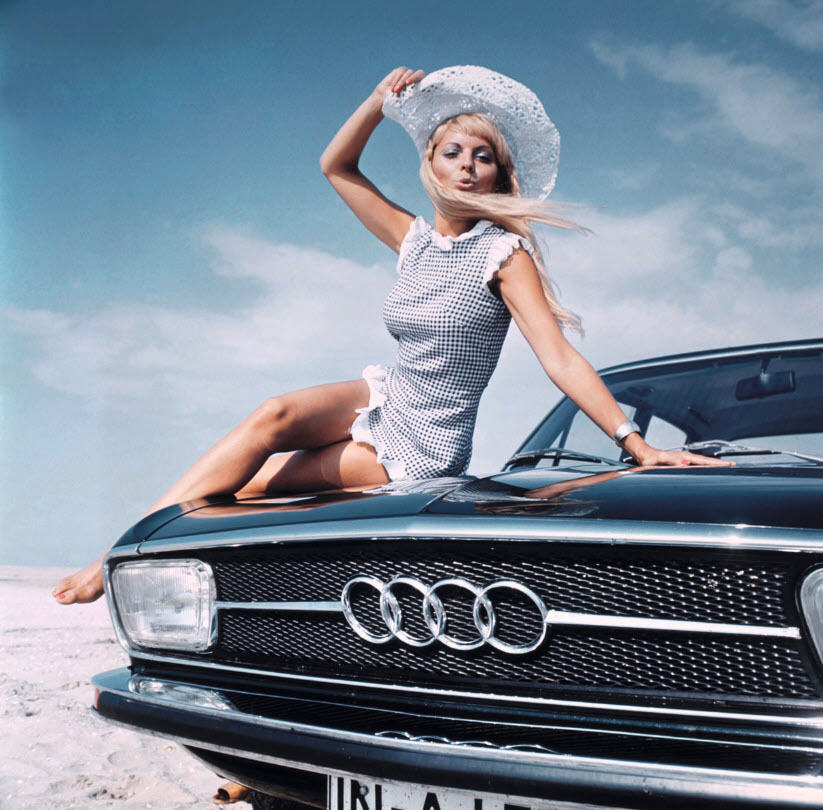
The Audi 80 was introduced in 1972, followed in 1974 by the Audi 50. With its modern product programme the company survived the oil-crisis years satisfactorily. In the latter half of the 1970s a policy of enhancing the Audi brand’s positioning step by step on the car market was initiated. The five-cylinder turbocharged engine, quattro all-wheel drive, the fully galvanised bodyshell, systematic weight-saving and – last but not least – high standards of design were among the landmarks of this policy.
Audi created a sensation in the spring of 1980 with the Audi quattro, the first high-volume car model with permanent all-wheel drive. The truly revolutionary, unrivalled nature of the quattro concept was seen when cars equipped in this way were entered for rallies: in 1982 Audi became the first German brand to win the hard-fought manufacturers’ world rally championship. In 1983 Hannu Mikkola took the driver’s world rally championship in the Audi quattro, and in 1984 Audi captured both titles – with Stig Blomqvist as the champion driver.
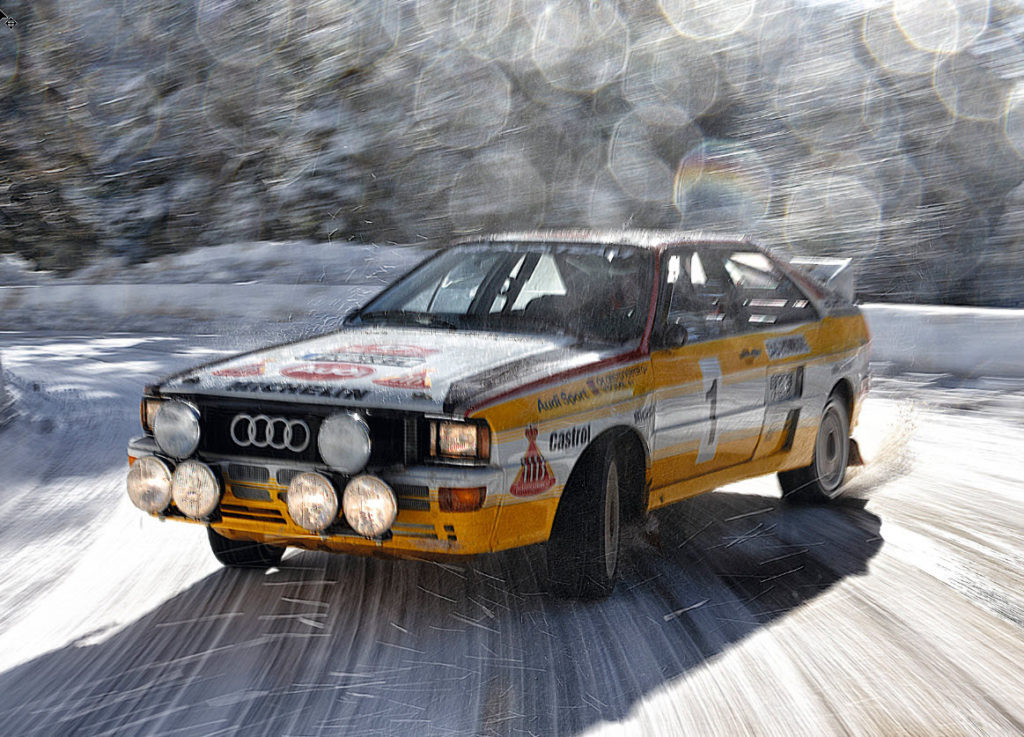
A world championship of a different kind went to Audi in 1982. The third-generation Audi 100, with a drag coefficient of cd = 0.30, had the best aerodynamics of any series-production saloon sold on the world market. Audi had come up with the best response to current demands for environmental acceptability and economy.
Forward to new dimensions
On 1 January 1985 Audi NSU Auto Union AG changed its name to AUDI AG and moved its head offices from Neckarsulm to Ingolstadt. Since then the company and its products have borne the same name. In the mid-1980s Audi, like other German carmakers, began to feel the consequences of public discussion on overall speed limits and reduced exhaust emissions. At this time too, such topics as active and passive safety had to be redefined.
In 1985 AUDI AG’s investments totalled almost a billion (thousand million) DM, until then the highest amount in the company’s history. The emphasis was on the products and on new production technologies. In the autumn of 1986 the company launched the new Audi 80, and set new standards in its class with a ten-year warranty against rust penetration for its fully galvanised body. 1988 saw the appearance of the Audi V8, the company’s first large luxury model, powered by a 3.6-litre V8 engine with four valves per cylinder.
The Audi 100 TDI made its debut in September 1989 at the Frankfurt Motor Show: the first diesel-engine passenger car with direct fuel injection. Various economy runs were carried out, and impressively confirmed the car’s low fuel consumption.
Audi ushered in a new era at the Tokyo Motor Show in 1993, by exhibiting an ASF (Audi Space Frame) all-aluminium design study. This car took over from the Audi V8 and was first displayed at the Geneva Motor Show in March 1994. The new model designation Audi A8 heralded a fundamental revision of Audi’s method of identifying its models. The Audi A6 followed in the summer of the same year as the successor to the Audi 100, and November 1994 the fifth-generation Audi 80 was also introduced as the Audi A4. This model became one of the key factors in Audi’s commercial success.
Vorsprung durch Design
At the beginning of the 1990s, in addition to its convincing progress in the automotive technology area, Audi began to lead the way increasingly in car design. It developed design-oriented strategies that made it one of the most sought-after automobile brands, with an individual but clearly identifiable formal idiom. The first examples of this new approach were the Audi quattro Spyder and Audi Avus quattro design studies that were first seen in the autumn of 1991, and with which AUDI AG was able to demonstrate its new aluminium construction principles to the public for the first time.
The company attached more and more importance to the topic of design in the years that followed. When the Audi TT was first seen as a sports coupé study in 1995, public enthusiasm for its design knew no bounds. The wave of emotion that overwhelmed the Audi brand was a source of inspiration for its engineers and designers.
Outlook
Audi has long been fulfilling its social responsibility on many levels – with the aim of making the future worth living for generations to come. The basis for Audi’s lasting success is therefore formed by environmental protection, the conservation of resources, international competitiveness and a forward-looking human resources policy. One example of AUDI AG’s commitment to environmental issues is the Audi Environmental Foundation. Within the context of “Vorsprung durch Technik,” which extends far beyond its products, the Company is directing its activities toward a major goal – comprehensive CO2-neutral mobility.
In turbulent times it is especially important not to lose sight of a clear objective, to exhibit responsibility and sustainability on one’s business activities – but also to be aware of one’s own roots. For Audi, these roots are to be seen in a heritage extending back for more than a century, beginning with automobile pioneer August Horch, and with Audi always in the forefront when it comes to the decisive shaping of automobile development.



